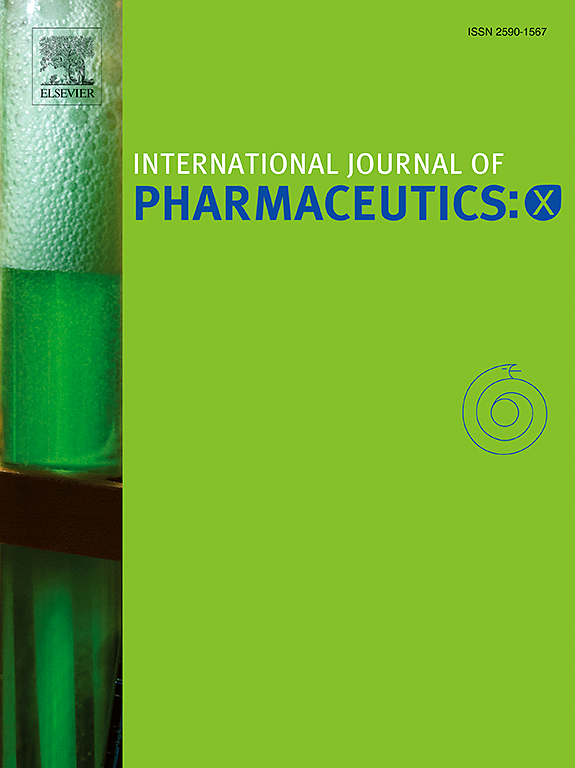Ocular mucoadhesive and biodegradable spanlastics loaded cationic spongy insert for enhancing and sustaining the anti-inflammatory effect of prednisolone Na phosphate; Preparation, I-optimal optimization, and In-vivo evaluation
IF 5.2
2区 医学
Q1 PHARMACOLOGY & PHARMACY
引用次数: 0
Abstract
This study aimed to formulate and statistically optimize spanlastics loaded spongy insert (SPLs-SI) of prednisolone Na phosphate (PRED) to enhance and sustain its anti-inflammatory effect in a controlled manner. An I-optimal optimization was employed using Design-Expert® software. The formulation variables were sonication time, the Span 60: EA ratio and type of edge activator (Tween 80 or PVA) while Entrapment efficiency (EE%), Vesicles' size (VS) and Zeta potential (ZP) were set as the dependent responses. This resulted in an optimum spanlastics (SPLs) formulation with a desirability of 0.919. It had a Span60:Tween80 ratio of 6:1 with a sonication time of 9.5 min. It was evaluated in terms of its EE%, VS, ZP, release behavior in comparison to drug solution in addition to the effect of aging on its characteristics. It had EE% of 87.56, VS of 152.2 nm and ZP of −37.38 Mv. It showed sustained release behavior of PRED in comparison to drug solution with good stability for thirty days. TEM images of the optimized PRED SPLs formulation showed spherical non-aggregated nanovesicles. Then it was loaded into chitosan spongy insert and evaluated in terms of its visual appearance, pH and mucoadhesion properties. It showed good mucoadhesive properties and pH in the safe ocular region. The FTIR, DSC and XRD spectra showed that PRED was successfully entrapped inside the SPLs vesicles. It was then exposed to an in-vivo studies where it was capable of enhancing the anti-inflammatory effect of PRED in a sustained manner with once daily application compared to commercial PRED solution. The spongy insert has the potential to be a promising carrier for the ocular delivery of PRED.

用于增强和维持泼尼松龙磷酸钠抗炎效果的眼部粘液粘附性和可生物降解的含阳离子海绵插件;制备、I-优化和体内评估
本研究旨在配制并从统计学角度优化磷酸泼尼松龙钠(PRED)海绵插件(SPLs-SI),以可控方式增强和维持其抗炎效果。使用 Design-Expert® 软件进行了 I-optimal 优化。配方变量包括超声时间、Span 60:EA 比率和边缘活化剂类型(吐温 80 或 PVA),而包封效率(EE%)、囊泡大小(VS)和 Zeta 电位(ZP)则被设定为因变量。这样就得出了一个最佳的跨塑料(SPLs)配方,其理想度为 0.919。该配方的 Span60 与 Tween80 的比例为 6:1,超声时间为 9.5 分钟。除了老化对其特性的影响外,还对其 EE%、VS、ZP、与药物溶液相比的释放行为进行了评估。它的 EE% 为 87.56,VS 为 152.2 nm,ZP 为 -37.38 Mv。与药物溶液相比,它显示了 PRED 的持续释放行为,并在 30 天内具有良好的稳定性。经优化的 PRED SPLs 制剂的 TEM 图像显示为球形非聚集纳米颗粒。然后,将其装入壳聚糖海绵插件中,对其外观、pH 值和粘附性进行了评估。结果表明,纳米颗粒具有良好的粘附性,在安全眼区的 pH 值也较高。傅立叶变换红外光谱(FTIR)、二沉积扫描光谱(DSC)和 X 射线衍射光谱(XRD)显示,PRED 成功地被包裹在 SPLs 囊泡中。随后对其进行了体内研究,结果表明,与市售的 PRED 溶液相比,每天使用一次的 SPLs 能够持续增强 PRED 的抗炎效果。这种海绵状插入物有望成为一种用于眼部递送 PRED 的载体。
本文章由计算机程序翻译,如有差异,请以英文原文为准。
求助全文
约1分钟内获得全文
求助全文
来源期刊

International Journal of Pharmaceutics: X
Pharmacology, Toxicology and Pharmaceutics-Pharmaceutical Science
CiteScore
6.60
自引率
0.00%
发文量
32
审稿时长
24 days
期刊介绍:
International Journal of Pharmaceutics: X offers authors with high-quality research who want to publish in a gold open access journal the opportunity to make their work immediately, permanently, and freely accessible.
International Journal of Pharmaceutics: X authors will pay an article publishing charge (APC), have a choice of license options, and retain copyright. Please check the APC here. The journal is indexed in SCOPUS, PUBMED, PMC and DOAJ.
The International Journal of Pharmaceutics is the second most cited journal in the "Pharmacy & Pharmacology" category out of 358 journals, being the true home for pharmaceutical scientists concerned with the physical, chemical and biological properties of devices and delivery systems for drugs, vaccines and biologicals, including their design, manufacture and evaluation. This includes evaluation of the properties of drugs, excipients such as surfactants and polymers and novel materials. The journal has special sections on pharmaceutical nanotechnology and personalized medicines, and publishes research papers, reviews, commentaries and letters to the editor as well as special issues.
 求助内容:
求助内容: 应助结果提醒方式:
应助结果提醒方式:


